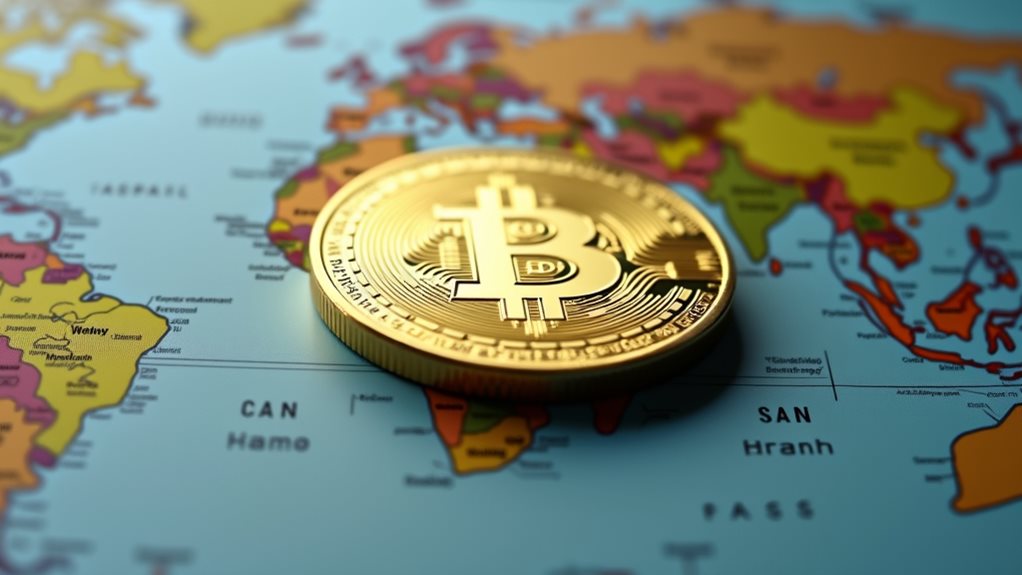Stablecoins are digital tokens pegged to assets like the US dollar, designed to remain steady when crypto goes haywire. They’re worth about $255 billion globally, with most tied to the dollar. You’re getting the stability of traditional money with the flexibility of crypto. They work through asset backing, over-collateralization, or algorithmic supply adjustments. After Terra’s 2022 collapse, smart investors approach algorithmic options cautiously. The best stablecoins offer protection without sacrificing your crypto dreams.
What Are Stablecoins and Why Do They Matter?

Crypto chaos, meet your match. While Bitcoin and Ether bounce around like caffeinated kangaroos, stablecoins maintain their cool, pegged to assets like the US dollar or gold.
In the wild west of digital assets, stablecoins stand firm—financial anchors in crypto’s stormy seas
They’re designed to do one thing: stay steady in a world of volatility.
Worth about $255 billion globally (with 99% tied to the USD), these digital tokens aren’t just another crypto fad. They’re reshaping market dynamics by offering what traditional cryptocurrencies can’t—predictability.
Stability matters. Period. When you need to transfer value without wondering if it’ll be worth half as much tomorrow, stablecoins deliver.
They’ve become critical for investor confidence in the broader crypto ecosystem, functioning as the steady backbone for everything from everyday purchases to cross-border payments. They also serve as a vital bridge between systems connecting traditional financial markets with emerging cryptocurrency innovations.
They provide a powerful economic lifeline in countries experiencing hyperinflation like Venezuela, allowing citizens to preserve their wealth when local currencies collapse.
Not perfect, but necessary.
The Evolution of Digital Stability in Volatile Markets

While Bitcoin made headlines for wild price swings, a quiet revolution was brewing in the background. Early experiments like BitUSD and NuBits in 2014 were clunky, imperfect attempts at digital resilience. They failed. But they planted seeds.
Fast forward to 2024, and stablecoins have exploded from $5 billion to a staggering $159 billion market. Not too shabby for what skeptics dismissed as crypto fantasy.
Today’s stablecoins aren’t just surviving market volatility—they’re thriving in it. They’ve evolved from simple pegged tokens to sophisticated systems with transparent reserves and diverse collateral models. The recent SEC clarification stance has brought newfound legitimacy to fully-backed stablecoins in the crypto ecosystem.
USDT, USDC, and DAI now power 45% of decentralized exchange liquidity.
The wild west of crypto finally got something resembling stability. Ironic, isn’t it?
These digital assets have become essential to the ecosystem, with trading volumes exceeding unbacked cryptocurrencies and providing much-needed predictability for merchants and users.
In regions facing economic instability like Lebanon, stablecoins serve as crucial wealth preservation tools where traditional currencies have catastrophically failed.
How Stablecoins Maintain Their Value Peg

Despite their seemingly magical stability, stablecoins don’t maintain their perfect $1.00 value through wishful thinking. They use concrete mechanisms. Hard cash.
Most stablecoins rely on asset backing—actual dollars or Treasury bills sitting in reserve. When Tether says it’s worth a dollar, there’s supposedly a real dollar backing it up. Asset liquidity matters enormously here. Crypto-backed stablecoins require over-collateralization to protect against the volatility of their backing assets.
Others use algorithms that automatically adjust supply. Price above $1? Create more coins. Below? Burn some. Simple math. Smart contracts dynamically adjust supply without requiring physical reserves, promoting a more decentralized approach.
Arbitrageurs do the rest, pouncing on any price gap like hungry wolves. Buy at $0.98, redeem at $1. Easy profit.
But everything hinges on market confidence. When that breaks? Well, just ask anyone who held TerraUSD in 2022. Spoiler: it wasn’t pretty.
Major Types of Stablecoins in Today’s Market

Now that you understand how stablecoins maintain their dollar value, let’s look at what’s actually out there in the crypto wilderness.
Fiat-backed coins like Tether and USDC dominate with their straightforward dollar stability approach. No surprises there.
Crypto-collateralized options like DAI bring decentralized governance to the table—overcollateralized for safety, but free from central control. Smart.
Then there’s the algorithmic experiments. Remember Terra/UST? Yeah, that went well.
Algorithmic challenges remain unsolved despite continued crypto innovations. Frax offers a unique hybrid solution combining collateralized and algorithmic mechanisms to maintain stability.
Don’t forget commodity-backed tokens offering gold-standard security—literally, in PAXG’s case. These asset-backed stablecoins are pegged to physical commodities like gold or real estate.
Finally, central bank implications loom large as CBDCs emerge.
Government-backed digital money is coming, whether you like it or not.
Regulation with benefits, censorship with convenience.
Real-World Applications Beyond Trading

Forget the crypto bro trading narrative for a minute—stablecoins are actually solving real problems for regular people.
They’re making finance work better for the underserved, rather than merely crypto traders.
1. Cross border payments without the ridiculous fees and wait times.
Sending money to family in Latin America? Traditional services take 3-5% of grandma’s grocery money. Stablecoins take pennies.
2. Merchant adoption has exploded, with 15,000+ businesses now accepting stablecoin payments.
No volatility means shop owners keep what they earn. Stablecoins offer significantly faster settlement times compared to traditional payment methods, allowing businesses to access funds almost instantly.
3. Protection against inflation in unstable economies.
Venezuelan bolivar or USDC? Easy choice.
4. DeFi access for everyone, rather than just the privileged few with perfect banking relationships.
The market capitalization of stablecoins now exceeds $220 billion, demonstrating their growing importance in the global financial ecosystem.
Let’s be honest—stablecoins aren’t perfect, but they’re fixing problems banks haven’t bothered to solve.
Comparing Risk Profiles Across Stablecoin Categories

While all stablecoins aim to maintain their peg to a reference asset, not all stability mechanisms are created equal—and the risks they carry can differ dramatically.
Centralized stablecoins offer high liquidity but expose you to regulatory whims and custodial failures. Your USDT could get frozen tomorrow. Seriously.
Crypto-backed options? They’re overcollateralized for a reason. Market crashes can trigger liquidation cascades that break even the best stability mechanisms.
Algorithmic stablecoins are the wild cards. Remember Terra/UST? Exactly. Their risk assessment often reveals fatal flaws—mathematical models that work until they suddenly don’t. The market has learned harsh lessons from these failures, contributing to the explosive growth from $4 billion to over $220 billion in market capitalization.
Hybrid designs attempt to balance these risks, combining different approaches. Smart, but more moving parts mean more potential breaking points.
The safest option? Depends on your paranoia level. Financial institutions now implement stress tests to evaluate stablecoin resilience under various market conditions.
Regulatory Landscape and Future Outlook

Understanding stablecoins means confronting their regulatory reality—a terrain shifting as rapidly as the technology itself.
The U.S. has finally gotten serious with the STABLE and GENIUS Acts, establishing clear rules for the stablecoin wild west.
Here’s what you need to know about the emerging regulatory framework:
- Issuers must maintain 1:1 reserves in high-quality assets—no more funny business with sketchy collateral.
- You’ll need a bank charter or federal license to play ball—sorry, garage startups.
- Monthly disclosures and audits are mandatory—transparency isn’t optional anymore.
- Interest payments to holders? Forbidden—reducing risk-taking behaviors.
These compliance requirements are no joke.
Regulatory challenges remain with state-issued stablecoins potentially creating loopholes in the system.
The newly established Stablecoin Certification Review Committee will be tasked with evaluating state regulatory regimes to ensure consistency.
But hey, at least there’s finally a framework. Better late than never, right?
This regulatory urgency emerged after stablecoin circulation skyrocketed to over $200 billion by 2023, highlighting the need for oversight.
Major players like Tether have demonstrated legitimacy by becoming US Treasury holders, now ranking as the seventh-largest holder globally with $33.1 billion in securities.
Integrating Stablecoins Into Your Crypto Strategy

Since diving into crypto feels like riding a rollercoaster blindfolded, stablecoins offer a rare moment of calm in the chaos.
They’re your financial safety net when Bitcoin decides to cliff-dive overnight.
Smart crypto portfolio diversification means keeping a healthy chunk in stablecoins.
Why? They hedge against volatility without forcing you back to fiat. No more margin calls ruining your sleep. Their fiat-backed nature provides the stability and predictability needed for everyday transactions while staying in the digital asset ecosystem. These digital assets offer fast transactions that are ideal for international settlements without the delays of traditional banking.
Stablecoin integration strategies aren’t rocket science.
Use them as collateral in DeFi instead of volatile assets. Transfer value globally in minutes, not days. Program automated compliance rules right into your transactions.
The best part? You’re still in crypto, just the boring, predictable corner of it.
Available 24/7, unlike your bank that’s apparently stuck in 1995. Stability doesn’t have to mean sacrificing your crypto ethos.
Frequently Asked Questions
Can Stablecoins Be Used Offline Like Physical Cash?
No, you can’t use stablecoins offline like cash. Stablecoin usability depends on blockchain verification requiring internet connectivity. Current offline transaction solutions remain experimental and don’t provide the immediate, connectivity-free exchange that physical cash offers.
How Do Stablecoins Handle Inflation of Their Pegged Currencies?
Stablecoins don’t mitigate inflation of their pegged currencies. When you hold a USD-pegged stablecoin during inflation, you’ll experience the same purchasing power loss as traditional dollars, sacrificing inflation protection for currency stability.
What Happens to Stablecoins During Blockchain Network Congestion?
During network congestion, you’ll experience transaction delays that slow your stablecoin transfers. You might face higher fees, reduced liquidity issues, and potential arbitrage difficulties that temporarily stress the peg’s stability.
Are Stablecoin Transactions Reversible if Sent to Wrong Addresses?
No, stablecoin transactions aren’t reversible once confirmed on blockchain. You can’t recover funds sent to wrong addresses. Always verify recipient addresses beforehand. Your only recovery option might be directly contacting the recipient for a voluntary return.
How Do Stablecoins Affect Traditional Banking Systems?
Stablecoins challenge your bank’s payment systems by offering faster, cheaper transfers while potentially reducing deposits. They’re prompting banking competition and regulatory scrutiny as traditional institutions adapt by creating their own tokenized solutions to stay relevant.








